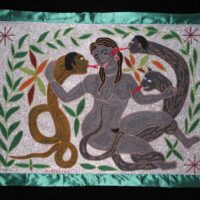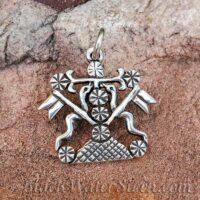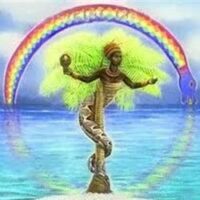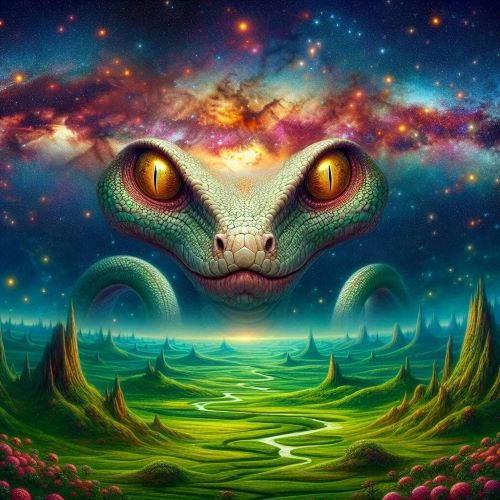Ayida Weddo : The Rainbow Serpent
Listen
At a glance
| Description | |
|---|---|
| Origin | Vodun Mythology |
| Classification | Gods |
| Family Members | Damballa (Husband) |
| Region | Benin, Suriname, and Haiti |
| Associated With | Fertility, Harmony, Protection |
Ayida Weddo
Introduction
Ayida Weddo, often known as the Rainbow Serpent, holds a revered place in Vodun mythology as a symbol of unity, protection, and creation. As a loa of the Rada nation, she embodies harmony between elemental forces and spiritual dimensions. Originating in West Africa—particularly among the Fon people of Benin—her worship traveled across the Atlantic with enslaved Africans, taking root in Haitian Vodou and other diasporic traditions. She is frequently invoked for her role in fertility, balance, and the preservation of cosmic order. Alongside her divine counterpart Damballa, Ayida Weddo forms a foundational force in the Vodun cosmology, intertwining sky and earth in an eternal embrace.
Physical Traits
Ayida Weddo is most vividly represented as a shimmering, multicolored serpent—her body flowing like a rainbow across the sky. Her serpentine form speaks to transformation and renewal, much like a snake shedding its skin. Artists often depict her in the ouroboros form—biting her tail—to convey infinity and the cycles of creation. Her ceremonial appearance typically involves white fabric, the color of purity, and often includes a jeweled crown or headdress to signify divine royalty.
Her sacred symbols extend beyond the visual. Rainbows, snakes, and thunderbolts are all associated with her energy. In Vodou ceremonies, she is evoked through fluid, undulating dance movements and is honored with offerings of white chickens, eggs, cotton, and milk—items that symbolize fertility, life, and cleansing. Rainbow-colored ribbons or fabrics are often used in her altars to reflect her spectrum of power.
Family
In Vodun mythology, Ayida Weddo is intimately tied to Damballa, the serpent spirit of wisdom and creation. Their relationship is more than marital—it is metaphysical. Together, they represent a divine duality: male and female, earth and sky, spiritual and physical. In some traditions, they are not merely partners but two aspects of a single spirit. This duality makes them essential to the creation of the universe, where Ayida spans the heavens while Damballa coils beneath the earth.
The dynamic between them exemplifies the concept of cosmic balance. While Damballa brings the grounding force of wisdom and structure, Ayida introduces grace, fluidity, and celestial movement. In other branches of Vodou, this union is expanded through associations with other loa, such as Erzulie Freda, adding complexity to the interconnected family of spirits.
Other names
Ayida Weddo is revered under a variety of names depending on regional dialects, linguistic evolution, and cultural contexts. Variations include Aida Wedo, Aido Quedo, Aido Hwedo, and Dan Ayida Hwedo. Each name reflects a slightly different phonetic expression of the same core deity, influenced by the languages of the Fon, Ewe, and Yoruba peoples.
In Haitian Vodou, she may also be referred to as Danbala Wedo when her identity is merged with or perceived as the feminine counterpart of Damballa. In some Caribbean and South American traditions, she mirrors the Yoruba orisha Oshumare, both being rainbow serpents connected to continuity and spiritual circulation. These name variations not only showcase the breadth of her veneration but also emphasize her adaptability across cultures and eras.
Powers and Abilities
Ayida Weddo’s influence extends across natural, spiritual, and cosmic realms. She governs the elements of wind, water, rain, fire, and thunder, orchestrating the forces that maintain ecological and metaphysical balance. As the Rainbow Serpent, she connects sky and earth, forming a bridge between divine energy and human experience.
One of her most profound powers is fertility—not just in a biological sense, but in terms of creativity, prosperity, and spiritual fruitfulness. She blesses her devotees with love, emotional stability, and inner peace. In Vodou cosmology, she is believed to support the world itself, her serpentine body coiled beneath the earth and arched across the sky, holding both in equilibrium.
Her transformative power also manifests in healing. Followers seek her guidance to overcome blockages, restore harmony in relationships, and navigate life’s transitions. Ayida Weddo’s essence invites flexibility, reminding worshippers of the need to flow with life’s changes rather than resist them.
Modern Day Influence
Despite the ancient origins of her worship, Ayida Weddo remains a vibrant presence in today’s spiritual and cultural landscapes. In Haiti, she is actively honored in Vodou ceremonies where priests and priestesses invoke her through dance, music, and ritual offerings. Her image frequently appears in drapo Vodou (ritual flags), which are elaborately beaded banners used in religious processions, often depicting intertwined rainbow-colored serpents.
Outside of religious practice, Ayida Weddo’s symbolism resonates in modern conversations about gender balance, environmental harmony, and ancestral wisdom. She represents both strength and gentleness, making her an emblem for those seeking to embrace duality and unity in their lives. Her influence is also evident in art, literature, and music across the African diaspora, where her imagery bridges cultural identity and spiritual resilience.
Her alignment with the rainbow makes her especially significant in today’s discussions about inclusivity and diversity. Some contemporary Vodou practitioners and artists interpret Ayida Weddo as a guardian of intersectionality—of all things that lie in between or across boundaries.
Moreover, she has inspired ecological reflection, encouraging a renewed respect for nature’s rhythms and the interconnectedness of all life. As climate change and environmental degradation raise existential questions, her mythos reminds humanity of the need for balance, cooperation, and reverence for the planet’s forces.
Related Images
Source
Coleman, W. (2000). Tribal Talk: Black Theology, Hermeneutics, and African/American Ways of “Telling the Story”. Pennsylvania State University Press.
Desmangles, L. G. (1992). The Faces of the Gods: Vodou and Roman Catholicism in Haiti. University of North Carolina Press.
Dorsey, L. (2005). Voodoo and Afro-Caribbean Paganism. Citadel Press.
Hurbon, L. (2022). Haitian Vodou. Open Encyclopedia of Anthropology. Retrieved from https://www.anthroencyclopedia.com/entry/haitian-vodou
Lawal, B. (2008). Èjìwàpò. African Arts, 41(1), 24-35.
Monaghan, P. (2014). Encyclopedia of Goddesses and Heroines. New World Library.
Owusu, H. (2002). Voodoo Rituals. Sterling.
Patheos. (2013). Rainbow Goddess Aida Wedo: Voodoo Prism Of Possibility. Retrieved from https://www.patheos.com/blogs/voodoouniverse/2013/11/rainbow-goddess-aida-wedo-voodoo-prism-of-possibility/
Wigington, P. (2024). The 8 Most Important Voodoo Gods. Learn Religions. Retrieved from https://www.learnreligions.com/voodoo-gods-4771674
Wilson, C. (2024). Cultural Symbolism of Snakes in Voodoo. Retrieved from https://chriswilsonstudio.com/snakes-in-voodoo/
Wikipedia contributors. (2024). Ayida-Weddo. Wikipedia. Retrieved from https://en.wikipedia.org/wiki/Ayida-Weddo
Frequently Asked Questions
What is lorem Ipsum?
I am text block. Click edit button to change this text. Lorem ipsum dolor sit amet, consectetur adipiscing elit. Ut elit tellus, luctus nec ullamcorper mattis, pulvinar dapibus leo.
What is lorem Ipsum?
I am text block. Click edit button to change this text. Lorem ipsum dolor sit amet, consectetur adipiscing elit. Ut elit tellus, luctus nec ullamcorper mattis, pulvinar dapibus leo.
What is lorem Ipsum?
I am text block. Click edit button to change this text. Lorem ipsum dolor sit amet, consectetur adipiscing elit. Ut elit tellus, luctus nec ullamcorper mattis, pulvinar dapibus leo.
What is lorem Ipsum?
I am text block. Click edit button to change this text. Lorem ipsum dolor sit amet, consectetur adipiscing elit. Ut elit tellus, luctus nec ullamcorper mattis, pulvinar dapibus leo.
What is lorem Ipsum?
I am text block. Click edit button to change this text. Lorem ipsum dolor sit amet, consectetur adipiscing elit. Ut elit tellus, luctus nec ullamcorper mattis, pulvinar dapibus leo.









